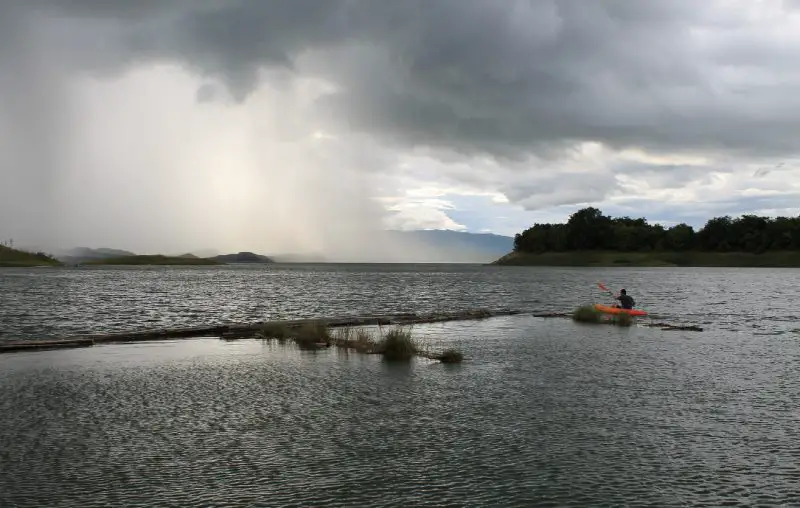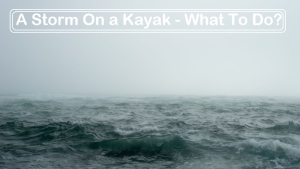Have you found yourself caught off guard by an unexpected tempest while kayaking? Firstly, maintain your composure! In the event that you are uncertain of the appropriate protocol during a storm, perusing this article will prove quite useful.

Get ready for your next thrilling rafting adventure with confidence. Equip yourself with the knowledge to avoid any distress and peril by perusing this comprehensive guide before setting off. Bear in mind that a storm is a formidable natural occurrence that has the potential even to imperil one’s very existence!
Table of Contents
What is a Thunderstorm?
A thunderstorm is a natural phenomenon that ensues as a result of the convergence of varying air strata. As frigid, dense air converges with relatively less dense, moisture-laden air, this exchange engenders air currents and the ensuing accumulation of thermal energy metamorphoses into electrical energy. The manifestation of this electrical energy is often observed in the form of lightning discharges in the sky. But whence does the sound of thunder originate? As the electrical discharge takes place, the air within rapidly expands in volume and, to equilibrate the pressure differential disseminates outwards at supersonic velocities. The consequential propagation of the shock wave that ensues can be discerned as a percussive blast, crackle, or rumble.
Rules Of Conduct During a Storm
- Consult meteorological forecasts. In this era of smartphones and the internet, such information may be promptly and readily accessed. Take heed to monitor meteorological reports prior to planning any kayaking excursion or other undertaking. Furthermore, do not disregard any weather-related warnings issued!
- Take refuge in a secure locale. If located indoors, ensure windows are tightly closed and unplug any electrical appliances. Conversely, if located outside, seek sanctuary or assume a crouching posture upon the ground; it is inadvisable to recline supine or cower beneath a tree!
- Cease driving. If traveling by automobile, it is judicious to disembark and await the passing of the tempest. Within the vehicle, one is secured from any hazards!
- Refrain from proximity to metals. Such items may include electrical devices, windows, doors, or ceilings.
- Have a flashlight at hand. During a thunderstorm, it is conceivable that electricity may abruptly be cut off – this is especially crucial if the storm transpires after nightfall.
- Ensure the well-being of oneself, as well as others! It is noteworthy that a person struck by lightning does not conduct it. When administering first aid, ensure that the stricken individual is in a secure position, and if necessary, administer CPR.
Canoeing During a Storm
To begin with, before embarking on a rafting expedition, it is advisable to refer to the first point of the preceding section. The foremost and pivotal measure to safeguard oneself from a tempest is to scrutinize the meteorological conditions. The scheduled date of the rafting trip can always be deferred to ensure it takes place under safe circumstances. In case the forecast predicts the occurrence of the phenomenon at a particular hour, and you are already kayaking, make every effort to reach the harbor an hour prior. However, if the storm takes you by surprise, seek refuge! The most suitable haven is the harbor shelters. If they are not within reach, take cover under a bridge or, if in an open area, locate a relatively lower point, wrap yourself in a tarp, and embrace your canoe. It is of utmost importance to vacate this canoe if possible and not be on the water.

In the absence of shelter or a bridge, a humble thicket providing a crouching space can serve as a safe haven to wait out the storm. Undoubtedly, the most secure solution is to refrain from navigating during turbulent weather conditions. However, unforeseen weather may catch us off-guard. Hence, it is prudent to select a kayaking route that comprises stopovers and protective shelters. Nevertheless, our top priority should always be to safeguard ourselves and others. Let us prioritize rescuing and assisting individuals in distress rather than worrying about equipment.
Kayaking On a River vs. on a Lake
During a canoeing expedition down a river during a thunderstorm, it is important to be aware that the most hazardous places are open areas without trees. Trees stand as beacons for lightning strikes, presenting an elevated risk. If the river runs through a densely forested region, it is prudent to seek refuge under low-lying foliage or a bridge. However, even on the lake, dangers lurk. Swift action to evacuate to the shoreline is imperative. Here, not only the lightning but also towering waves caused by gusts of wind could pose a peril.
Why Avoid Water During a Storm?
The solution is straightforward – water is a proficient conductor of electricity! Hence, it is crucial to abandon the canoe at the first indication of a storm. Merely observing the sky can be immensely helpful! Atmospheric clues can alert us to the likelihood of a storm and its proximity. For example, lightning unaccompanied by thunder indicates that the tempest is approximately 70 kilometers away from us – the ideal moment to make our escape :). If faint rumblings can be heard, then the storm has approached within 25 kilometers of our location. We can also readily estimate the storm’s distance by dividing the seconds between the flash and the thunder by 3, enabling us to gauge the storm’s proximity.
Сonclusion
In the event of a storm while kayaking on a lake, prompt evacuation to the shore is imperative to avoid the perils of lightning strikes and turbulent waves, arising from gusts of wind. It is equally crucial to keep a close watch on the weather and interpret its telltale signs, such as silent lightning or faint rumblings. By staying vigilant and taking preemptive measures, kayakers can relish a safe and delightful trip, despite a stormy encounter.
FAQ
How much wind is unsafe for a kayak?
As an expert, I would say that the amount of wind that is unsafe for a kayak depends on several factors such as the size and weight of the kayak, the experience and skill level of the kayaker, and the conditions of the water body being paddled on. Generally speaking, wind speeds of 15–20 knots (17–23 miles per hour) can make kayaking difficult and potentially hazardous, especially for novice or inexperienced kayakers. When wind speeds reach 20–25 knots (23–29 miles per hour), conditions become even more challenging and dangerous, with waves reaching up to 4 feet or more. At this point, kayakers should avoid being out on the water altogether. It’s always important to check the weather forecast before setting out on a kayaking trip, and to err on the side of caution when wind speeds are high. Additionally, kayakers should always wear a personal flotation device and carry safety equipment such as flares and a whistle in case of an emergency.
What does it mean when a kayak capsized?
When a kayak capsizes, it means that the kayak has overturned and is no longer upright on the water. This can happen due to various reasons such as rough water, strong winds, or improper balance of weight. Capsizing can be dangerous for the paddler, especially if they are not wearing a proper life jacket or if they are in cold water. It can also lead to loss of equipment and supplies.
If a kayak capsizes, the paddler should stay calm and try to hold onto the kayak and any floating equipment. If the water is cold, it is important to try to stay afloat and reduce the risk of hypothermia. The paddler should also try to swim to the nearest shore or wait for rescue if necessary.
Capsizing can be prevented by proper kayak handling, maintaining balance and weight distribution, and following safety guidelines. It is also important to be aware of weather conditions and water conditions, and to avoid kayaking in conditions that exceed your skill level. Proper training and equipment can also reduce the risk of capsizing and increase the chances of a safe and enjoyable kayaking experience.
What is it called when you flip over in a kayak?
When a kayaker flips over or rolls over in their kayak, it is called a “capsizing” or “capsize.” Capsizing can happen due to various reasons such as strong currents, rough waters, or a kayaker’s lack of skill or experience. When a kayak capsizes, the kayaker can fall out of the boat and be submerged underwater, which can be dangerous if the kayaker is not wearing a properly fitted personal flotation device (PFD). Capsizing can also result in injuries, especially if the kayaker hits rocks or other obstacles in the water. Therefore, it is essential for kayakers to receive proper training and to always wear appropriate safety gear to minimize the risk of capsizing and ensure their safety while kayaking.
How do you fight wind in a kayak?
Kayaking in windy conditions can be challenging, but there are several techniques you can use to fight the wind and maintain control of your kayak. Here are some tips:
1. Position yourself properly: Sit in the center of your kayak, with your feet braced against the footrests. This will help you maintain balance and control as you paddle.
2. Use proper paddling technique: Use a low-angle stroke, keeping your hands close to your body and your elbows bent. This will help you maintain a steady pace and reduce the amount of wind resistance.
3. Paddle into the wind: Point your kayak directly into the wind and paddle with a strong, steady rhythm. This will help you make progress against the wind, although it may be slower than your usual pace.
4. Use a rudder or skeg: If your kayak is equipped with a rudder or skeg, use it to help keep your kayak on course. A rudder can be adjusted to compensate for wind direction, while a skeg can help keep your kayak tracking straight.
5. Lean into the wind: If you encounter strong gusts of wind, lean into them to maintain your balance. This will help prevent your kayak from tipping over.
Remember, safety should always be your top priority when kayaking in windy conditions. If the wind becomes too strong or you feel uncomfortable, consider turning back or finding a safe place to wait until the conditions improve.
Our best posts:

